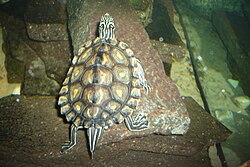Conservation status
This species is listed as threatened under the US Endangered Species Act due to a recent decline. This can be attributed to a low reproductive frequency as compared with most other map turtles. A high level of nest mortality due to fish crow predation and river flooding are also attributed to endangerment. Unexpectedly high occurrences of nesting in shaded areas could possibly be attributed to human disturbances on and near sandbars, which raises mortality rates. [7] Human disturbances are primarily boating activities that are popular in the Pascagoula of Mississippi increasing the female turtle's energetic cost of nesting overall preventing their population to grow. [8]
Also, its habitat suffers from pollution and agricultural changes to water levels, affecting nesting beaches. "Turtle plinking", shooting turtles for casual target practice, kills significant portions of this endangered turtle's population each year. [9]
Since yellow-blotched map turtles are freshwater turtles mainly found in the Pascagoula River of Mississippi, human disturbances like an increase in boats in the area of inhabitance, also leads to many physiological issues due to less time to bask or endangerment of the nest. [10]
As a member of the listed Graptemys genus, G. flavimaculata receives protection under Appendix III of the Convention on International Trade in Endangered Species of Wild Fauna and Flora (CITES). [11]
This page is based on this
Wikipedia article Text is available under the
CC BY-SA 4.0 license; additional terms may apply.
Images, videos and audio are available under their respective licenses.




